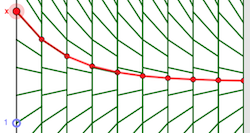Blog Posts
Here are links to posts on my Math Education Blog that you might find interesting.
If you are so moved, you may comment on the posts, and/or subscribe to the blog.
Commitments
A central challenge for all of us is the tension between our commitment to mathematics, on the one hand, and our commitment to our students on the other. I wrote about it in 2013, and more generally about the concept of embracing opposites in 2015. But there is a third commitment which interferes with both of these: a disproportionate emphasis on enforcing student compliance. Read about it here.
The California Math Framework Revision
California is rethinking its K-12 math program. The goal of the revision is to reduce learning gaps, including by de-tracking secondary school classes. I support this, but I worry that implementation is not going to be easy, and I fear that a possible backlash may drastically set us back, as happened after the 1992 Framework was adopted. Read about this here.
Big-Picture Planning
In my role as math department chair I could not limit myself to planning individual lessons. I learned early on that effective lesson plans depend largely on well-thought-out plans for units, courses, and in fact the whole high school math program. In the past few years, I wrote a number of blog posts about the need to zoom out and see the big picture. I recently concatenated and edited some of those posts into an article on my website: Big-Picture Plannning.
MathEducation.page
New and newish on my website.
Sequences and Series, Formulas
A recurrent question in teaching secondary school math is about the pedagogical use and misuse of formulas. One approach is to teach a formula, and have the students practice using it. Another is to minimize memorization without understanding by encouraging students to rethink each problem from first principles. In a new 10-minute video about Sequences and Series, I articulate a middle course: formulas should encapsulate understanding, not substitute for it.
Games
Three math games, implemented as GeoGebra applets:
- Signed Numbers: In this new game, students practice signed number arithmetic, their understanding of decimals, and their estimation skills.
- Complex Numbers: This is the same game for complex arithmetic. It's been on my site a long time, but I recently fixed a bug and slightly improved the interface.
- Pent: This two-person strategy game was invented by George Mills. It is inspired by Hex, but it is played on a flattened and stretched-out soccer ball.
Functions
Functions, of course, are a major topic in middle school and high school. I recently added some material aimed at Algebra 2 and Precalculus.
- Window Shades: Lessons about rate of change by Rachel Chou. They are inspired by the Doctor Dimension concept, but they are somewhat more "real world".
- Tri, Tri Again, an interesting application of iterating linear functions to geometry. (Suggested by Rachel Chou.)
- Two linked function diagram applets to visualize the composition and iteration of functions. You can use them to make images for copy-pasting into a word processor or presentation software.

Geometry of the Parabola
In my already substantial Geometry of the Parabola page, I added:
- An eight-minute video guide to a construction of the parabola in GeoGebra (or in some other interactive geometry application)
- Yet more evidence that all parabolas are similar. This time an applet showing that given two parabolas with parallel axes of symmetry, one is a dilation of the other.
- A new GeoGebra applet to show the parabola as the envelope of a family of lines

Symmetry
Two small changes to my Symmetry materials:
- I improved my Spirograph Simulation: it is faster, and it is now possible to hide the moving parts so as to better see the final image.
- I added pattern block creations by Hana Murray and Simon Gregg to the Dodecagons and Wallpapers Catalog pages.
Popular Pages
According to Google, these are the "top growing" and "top performing" pages and queries for my website in the past five months.
From Algebra: Themes, Tools, Concepts
- Equations vs. Identities — some basic pre-algebra
- The Cover-Up Method — an alternative approach to equation-solving.
- Algebra Magic — analyzing and inventing "magic" tricks
- Working Backwards — a whole chapter
- Constant Sums, Constant Products, Constant Differences, Constant Ratios — an untraditional approach to traditional topics
- Skidding Distance, a "real world" application of the square root function — a perennial hit, inexplicably
Transformational Proof:
- Transformational Proof in High School Geometry — a rigorous development, co-authored with the late Lew Douglas.
- Transformational Proof Basics — a subset and predecessor of the above. I don't know how people found it, as I don't think I link to it anywhere.
- Triangle Congruence and Similarity (v1, v2),another predecessor of Transformational Proof — both versions are interesting for different reasons.
Algebra 2 / Precalculus
- From Factored to Standard Form, a parabolas worksheet — another perennial hit, according to Google
- Geometry of the Parabola — construction, reflection property, and more
Puzzles
- Virtual Pentominoes — great puzzles online!
- Pentomino Puzzle Books — great puzzles in free downloadable books!
- Number Pyramids — addition-based puzzles for upper elementary and middle school students
Other:
- Using the Geoboard — a versatile manipulative learning tool
- Virtual Grid Paper — for non-graphing uses
- Symmetry — K-12 activities!
- Math Education — the front page
